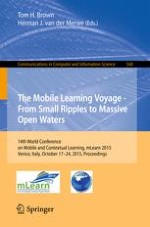2015 | OriginalPaper | Buchkapitel
Learning with Wearable Technologies: A Case of Google Glass
verfasst von : Daniyar Sapargaliyev
Erschienen in: The Mobile Learning Voyage - From Small Ripples to Massive Open Waters
Aktivieren Sie unsere intelligente Suche, um passende Fachinhalte oder Patente zu finden.
Wählen Sie Textabschnitte aus um mit Künstlicher Intelligenz passenden Patente zu finden. powered by
Markieren Sie Textabschnitte, um KI-gestützt weitere passende Inhalte zu finden. powered by
